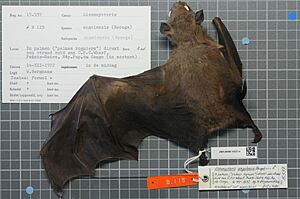Angolan rousette facts for kids
Quick facts for kids Angolan fruit bat |
|
|---|---|
 |
|
| Conservation status | |
| Scientific classification | |
| Genus: |
Myonycteris
|
| Species: |
angolensis
|
 |
|
| Angolan rousette range | |
| Synonyms | |
|
|
The Angolan fruit bat, also called the Angolan rousette or silky bat (Myonycteris angolensis), is a type of megabat. These bats are part of the Pteropodidae family. You can find them in many African countries. These include Angola, Burundi, Cameroon, and the Central African Republic. They also live in the Republic of Congo, Democratic Republic of Congo, Kenya, Nigeria, Rwanda, Sudan, Tanzania, Uganda, and Zambia. Their favorite places to live are moist lowland forests, wet savannas, and rocky areas.
Contents
About Its Name
This bat was first described in 1898. A Portuguese zoologist named José Vicente Barbosa du Bocage gave it its scientific name.
Bocage first put it in a group called Cynonycteris. He named it C. angolensis. The name "angolensis" means "Angolan" in Latin. This is likely because the first bat studied was found near Pungo Andongo in Angola.
What It Looks Like
The Angolan fruit bat is a medium-sized bat. Its forearm, which is part of its wing, measures about 68 to 90 millimeters (2.7 to 3.5 inches) long. It usually weighs between 60 and 87 grams (2.1 to 3.1 ounces).
What It Eats and How It Lives
This bat is a frugivore. This means it mostly eats fruit. It enjoys fruits from different trees. These include fig trees, Anthocleista, Milicia excelsa, and Adenia.
Where It Lives
The Angolan rousette lives across a large part of Africa. You can find it in West, East, and Central Africa. It lives in places from sea level all the way up to 4,000 meters (13,000 feet) high.
Conservation Status
As of 2017, the IUCN (International Union for Conservation of Nature) lists this bat as a least-concern species. This is good news! It means the bat is not currently at high risk of disappearing.
It has this status for several reasons:
- It lives in a very wide area.
- Its population is thought to be large.
- It lives in many protected areas.
- Its numbers are not dropping quickly.
- It can handle some changes to its habitat caused by people.


